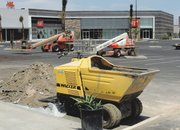ALMOST DONE: Azalea, one of the only regional malls built in the state this year, is scheduled to wrap up construction in early summer.
AZALEA
New Mall With a Civic Angle Hopes to Lift Economy in South Gate, Calif.
One of Los Angeles County’s new retail hot spots is South Gate, a blue-collar, predominantly Latino city with a high unemployment rate.
South Gate is the address for Azalea, one of the few regional malls being constructed in the state. The 375,000-square-foot mall is located at the intersection of Firestone Boulevard and Atlantic Avenue. Construction is scheduled to be wrapped up in early summer, said Arturo Sneider, the founding partner and chief executive officer of Azalea’s developer, Primestor Development Inc.
Azalea will be the site of the first F21 Red, a highly anticipated new store concept from Forever 21 Inc., which is scheduled to open May 10. Only one storefront in the development has not been leased, Sneider said. Big-box stores Walmart, Marshalls and Ross Dress For Less have opened recently. The place also offers popular restaurants such as In-and-Out Burger and T.G.I.Fridays.
The mall is forecast to help fuel an economic turnaround for South Gate and will offer residents help in getting a job and building a career. City officials and consultants to the project said Azalea is getting a great piece of economic news for a city that is home to many economically disadvantaged residents. In March, South Gate had an unemployment rate of 11.2 percent, according to the Bureau of Labor Statistics, compared with the state’s unemployment rate of 8.4 percent. However, with a population of more than 92,000, it is one of the most densely populated cities in Los Angeles County, said Larry Kosmont, president and chief executive officer of Kosmont Companies, a consultant to the project.
“This is an example of a largely Hispanic city losing millions in retail sales because there was an insufficient presence of primary retail tenants in the city,” Kosmont said.
Azalea cost $107 million to build but is forecast to generate $2.5 million in sales tax, $55,700 in property tax and $52,900 in business-license tax per year. A city forecast predicted the mall would generate sales of $350 per square foot, but Sneider forecast it would be $500 per square foot.
Development of the mall also provided 597 construction jobs, and the center is expected to offer 798 permanent jobs. Azalea offers a “local-hire” program, which requires retailers and contractors to give residents of South Gate and the surrounding areas preferential treatment when hiring.
The city of South Gate also required developers to set aside civic space for public use. A more than 1,500-square-foot plaza with a patio at Azalea is reserved for classrooms and group meetings, said Steve Lefever, director of community development for the city of South Gate. Many of the classes will be devoted to job training and higher education.
A mall with a civic angle will be key to Azalea’s success, Sneider said. “We believe that, as developers, we are truly facilitators of a community’s vision of itself. … The local economy and its citizens’ hopes, dreams and financial stability are the key drivers of success in this field.”
Community demand
South Gate’s city council had been lobbying developers for years to build a mall in its city. An opportunity came up when the Los Angeles Community College District sold a former industrial site to a developer that intended to make it into a mall. The developer ran out of money around 2007, and the project remained on the backburner during The Great Recession. But Lefever said the promise of a mall had captured the imagination of South Gate residents.
“During the recession the community did not forget what was promised,” Lefever said. “They constantly brought it up at council meetings—‘You promised, you promised. Now deliver,’” he said.
But there were hiccups on the way to finding a new developer. Lefever said the project had to scramble for new funding a few times. In 2013, the state of California eliminated its redevelopment agencies, and these public programs had often helped in funding projects such as Azalea. The project also had been pitched as a public/private partnership during a time when municipal bankruptcies by big towns such as San Bernardino and Stockton made headlines. In addition, South Gate’s neighboring city of Bell was embroiled in a major corruption scandal. South Gate had emerged from a civic scandal of its own a decade earlier when Albert Robles, former city treasurer, along with three accomplices on the city council, accepted bribes and gave taxpayer-funded city hall contracts to friends and relatives. Robles was convicted of bribery in 2005.
But Primestor, a minority-owned business with a focus on developing in urban communities, signed on in 2010 to build the mall. Financing came from Wells Fargo, which also happens to be a tenant in the new mall, as well as public monies from a South Gate utility fund from a bond issue, grants for road improvements and tax credits.
“This is an example of how you use public-agency economics and incentive programs to induce private investment,” Kosmont said. “In the case of the Azalea project, it was done in a way that created a community, cultural and social center that provides a sense of place for the residents. It’s creating a neighborhood instead of a strip mall.”
The sentiment has been echoed by some South Gate residents. “I was so tired of hearing that South Gate had nothing to offer,” Marilu Gonzalez said on Azalea’s Facebook page. “I am so excited to see this project getting completed.”
























